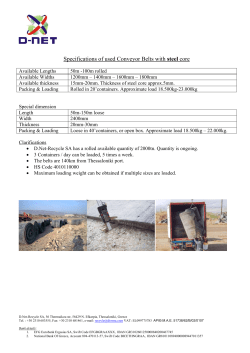
Volvo Part Analysis
DFMPro analysis For XYZ 1 Machining: DFMPRO ANALYSIS Confidential Deep Holes Explanation : Deep, small diameter holes are difficult to machine. Smaller diameter drills tend to wander and are prone to break, therefore, they are not recommended for convenient mass production. Chip removal becomes difficult while drilling deep holes. Deep Holes: The depth to diameter ratio: Actual depth to diameter ratio: 10 mm Recommended depth to diameter ratio: <8.0 mm Recommendation: Try to avoid deep holes with small diameters. Confidential Entry/Exit surface for holes Explanation : When the drill tip contacts the surface, the tip will wander if the surface is not perpendicular to the drill axis. Exit burrs will be uneven around the circumference of the exit hole. This can make burr removal difficult. Surface at Entry / Exit of drilled hole is not perpendicular to the hole axis. Recommendation: Drills should enter and exit surfaces that are perpendicular to the centerline of the hole. Confidential Standard Hole sizes Explanation : Unusual hole sizes increase the cost of manufacturing through purchasing and inventory costs. The diameter of this hole, 12.583 mm, is not a standard hole diameter. 12.5 mm and 12.8 mm are the nearest standard hole diameters. The diameter of this hole, 18.028 mm, is not a standard hole diameter. 18.0 mm and 18.5 mm are the nearest standard hole diameters. Recommendation: Try to use standard hole sizes which can be configured in the rule configuration window. Confidential Injection Molding: DFMPRO ANALYSIS Confidential Recommended Rib Parameters Explanation : On a plastic part, ribs are added as protrusions along the length. Ribs can serve a number of purposes. They can add strength to a part or act as a decorative feature to a part design. Ribs can stiffen and strengthen the molded part while maintaining a minimum wall thickness. However, projections like ribs can create cavity filling, venting, and ejection problems. Rib thickness (3.481 mm) to nominal wall thickness (3.0 mm) ratio is 1.16 whereas it is recommended to be <= 0.4 (Recommended Rib thickness <= 1.2 mm). Rib thickness (3.697 mm) to nominal wall thickness (3.0 mm) ratio is 1.232 whereas it is recommended to be <= 0.4 (Recommended Rib thickness <= 1.2 mm). Rib height (22.966 mm) to nominal wall thickness (3.0 mm) ratio is 7.655 whereas it is recommended to be <= 2.5 (Recommended Rib height <= 7.5 mm) Rib height (10.0 mm) to nominal wall thickness (3.0 mm) ratio is 3.333 whereas it is recommended to be <= 2.5 (Recommended Rib height <= 7.5 mm) Recommendation: Generally, rib height is recommended to be not more than three times nominal wall thickness. Similarly, rib thickness at its base should be around 0.6 times nominal wall thickness. Confidential Minimum Draft Angle Explanation : Draft angles should be designed properly to assist in part ejection. This also reduces cycle time and improves productivity. Draft angles should be used on interior or exterior walls of the part along the pulling direction. Draft for core of 0.0 deg Recommended: 0.5 deg Missing draft cases at core Recommendation: Generally a draft angle of 0.5 deg. is recommended for core and for cavity areas. Confidential Minimum radius at base of Boss: Explanation : Bosses find use in many part designs as points for attachment and assembly. The most common variety consists of cylindrical projections with holes designed to receive screws, threaded inserts, or other types of fastening hardware. Under service conditions, bosses are often subjected to loadings not encountered in other sections of a component. A fillet of a certain minimum radius value should be provided at the base of boss to reduce stress. Also, the radius at the base of boss should not exceed a maximum value to avoid thick sections. The radius at the base of boss is 0.25 mm which is 0.083 times the nominal wall thickness of the part, whereas it is recommended to be >= 0.75 mm i.e. 0.25 times the nominal wall thickness of the part. The nominal wall thickness of the part is 3.0 mm. Recommendation: The suggested value for minimum required radius at the base of boss is 0.25 times nominal wall thickness. Confidential Mold Wall Thickness Explanation : Mold wall thickness gets affected due to spacing between various features in the plastic model. If features like ribs, bosses are placed close to each other or the walls of the parts, thin areas are created which can be hard to cool and can affect quality. If the mold wall is too thin, it is also difficult to manufacture and can also result in a lower life for the mold due to problems like hot blade creation and differential cooling. The Mold wall thickness is 0.319 mm which is 0.106 times the nominal wall thickness (3.0 mm) of the part whereas it is recommended to be >= 6.0 mm i.e. 2.0 times the nominal wall thickness of the part Recommendation: Minimum allowable mold wall thickness needs to be decided based on process and material Thin areas areto created can beof hard to cool and can features affect quality. If the considerations. However it is normal have which clearances 1 mm between of an injection molded plastic part thus mold wall is too thin, it is also difficult to manufacture and can also result in a allowing a mold wall of that dimension. lower life for the mold Confidential END OF PRESENTATION The material contained in this deck represents proprietary, confidential information pertaining to products, technologies & processes from Geometric. All information in this document is to be treated in confidence. The names and trademarks used in this document are the sole property of the respective companies and are governed/ protected by the relevant trademark and copyright laws. © Geometric Limited | info@geometricglobal.com | www.geometricglobal.com Confidential |
© Copyright 2025








